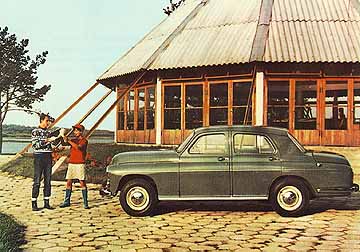By
1951 the FSO factory was completed and at 2 pm on November 6 of that year
the first Pobieda, renamed Warszawa (Polish for Warsaw), rolled of the
assembly line. The factory was capable of producing 25,000 cars yearly,
but the production of the Warszawa never came close to this level. The
reason was that the M20 was a very wasteful construction, requiring excessive
amounts of materials and workmanship. Throughout its production period
the Warszawa was continuously improved and up to 18,000 were being made
by the late sixties. At first the M20 was being constructed of parts sourced
from the Soviet Union, but by 1956 it was completely of Polish content.
In 1960 the M20 became the 201 and two years later the 2.1-litre 4-cylinder engine's power output was increased from 53 bhp @ 3600rpm to 70 bhp @ 4000rpm, resulting in the 202. A sedan version, the 223, of the Warszawa was also put into production in 1964, along with a station wagon version, model 224. Pick-up, ambulance, taxi, and a few other versions were also available, including one with steel wheels for moving on rails (really!).
Nineteen-sixty-four saw the completion of Warszawa 210 prototype (started in 1961), but nothing came of it as a license for the Fiat 125 (discussed later) was obtained around that time. Too bad, the 210 looked like a promising design.


Warszawa brochure pics supplied by Paul Negyesi
Production of the Warszawa was suspended in 1973, after 254 421 had rolled off the assembly line.
From a postcard, copyright J. Yerka / Konkret